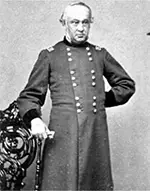Civil War General Henry Halleck
Henry Halleck was a well-known administrator and military theoretician who was general-in-chief for a time during the American Civil War. 
He was born on Jan. 16, 1815, in Westernville, N.Y. His father, Joseph Halleck, had fought in the War of 1812. Young Joseph preferred more urbane pursuits than could be found on his father's farm so went to Utica, N.Y., to live with his uncle, David Wager, who was previously a state congressman. Henry attended Hudson Academy and Union College and then went to West Point, at age 20. His academic background earned him the nickname "Old Brains" and the opportunity to teach classes while still a student. He graduated third in his class in 1839 and so impressed Maj. General Winfield Scott with his Report on the Means of National Defense that he won a promotion and a trip to France to further study his area of expertise, coastal fortifications. A few years later, he returned to the U.S. and gave a series of lectures at the Lowell Institute that led to the publication of his book Elements of Military Art and Science. That book came out in 1846, the same year that the Mexican-American War began. Halleck found himself appointed to California and so out of the major fighting, although he did take part in Commodore William Shubrick's capture of Mazatlán in November 1847. He spent time during the war translating into English a study on Napoleon by the famed French general Antione-Henri Jomini. Embracing politics, Halleck helped write the California Constitution and ran for state senate, narrowly losing the election. He studied law and founded a law practice that proved more appealing than the military, so he resigned his commission, in 1854, and got married, to Elizabeth Hamilton, granddaughter of Alexander Hamilton. They had one child, Henry, Jr. When the Civil War began, he rejoined the Army as a major general and was named to command the Department of Missouri. He oversaw a number of campaigns in the western theater, including victories at Pea Ridge, Island No. 10, Fort Henry, and Fort Donelson. 
Halleck was higher in rank than Ulysses S. Grant and was unhappy with Grant's performance at the Battle of Shiloh. Halleck left his headquarters in St. Louis and personally took command of the troops in the field. He led the Union advance on Corinth, Miss., and directed the capture of that crucial city, on May 30, 1862. However, it took him two months to move his army 22 miles, and the Army of Tennessee had plenty of time to escape. He proved himself much more capable as a military theoretician than a battlefield commander. However, Halleck performed expertly in keeping Missouri from joining the Confederacy and in overseeing a number of high-profile penetrations into the interior of Tennessee. President Abraham Lincoln named Halleck commander-in-chief of the Union armies, and Halleck reported to Washington, D.C., to begin that assignment on July 23, 1862. His first job was to rebuild momentum for the Union, in the wake of the failure of the Peninsula Campaign, the brainchild of Gen. George McClellan. Halleck replaced McClellan in the top job. Halleck's natural caution combined with McClellan's reluctance to send his men into combat spelled disaster for the Union at the Second Battle of Bull Run, as Gen. John Pope was forced to fight the battle all on his own, with the result the same as had been the case for the first battle of that name and at that place: a Confederate victory. Throughout 1863, Halleck found himself increasingly ignored and sidelined by both his subordinates and his superiors, namely Lincoln and Secretary of War Edwin Stanton. Grant, Halleck's former subordinate, had a winning reputation by 1864 and, in March of that year, was appointed to succeed Halleck as general-in-chief; the latter became chief-of-staff. Halleck kept the supply of men and supplies streaming along the various fronts, ensuring that the North had enough men and materiel to win the war. In 1865, after the end of the Civil War, Halleck found himself again in California, appointed as head of the Division of the Pacific. During his tenure, that administration included that of Alaska, purchased in 1867 from Russia. In 1869, Halleck reported to Louisville, Ky., to head up the Military Division of the South, as part of Reconstruction. He died at his post on Jan. 9, 1872, from complications of heart and liver disease. He was 56. |
|
Social Studies for Kids
copyright 2002–2024
David White




